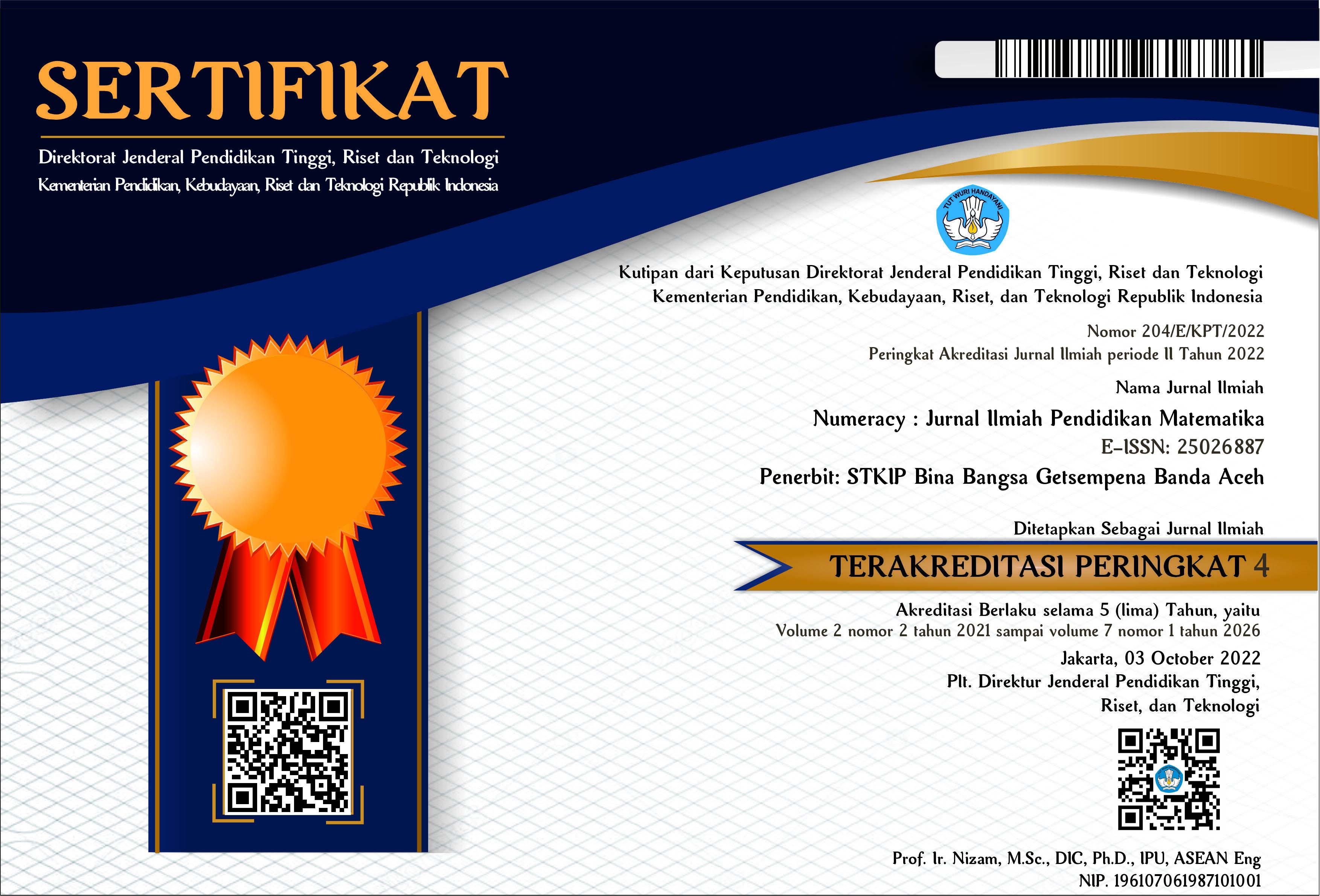DISCOURSE TOWARD STUDENTS WHO HATE MATHEMATICS IN SOLVING A MATHEMATICAL PROBLEM: AN ETHNOMATHEMATICAL PERSPECTIVE
Abstract
This research aims to identify students who hate mathematics in solving mathematical problem where culture is the context. In this research the context was Rumoh Aceh. By collecting data through various sources such as interview transcription and documentation, qualitative method is appropriate to describe how students who hate mathematics solve the mathematical problem. Students who hate mathematics, they hate mathematics is not simply because mathematics is difficult for them, rather their awareness toward mathematics itself. Roughly speaking, what they consider as not mathematics is mathematics. From several respondent who involve in this research, all of them have their own way in solving mathematical problem. In other way, all students who hate mathematics can solving mathematical problem, even all the answer is not match with the real needs of an Utoh. Utoh is a professional worker who expert in counting the total weaved rumbia leaves to cover whole roof of Rumoh Aceh. Students who consider mathematics as their enemy which means they hate mathematics cannot be said that they cannot solve mathematical problem at all, but they have the strategy to solve it, although they face some problem in the process of solving it. All of students’ answer called as alternative solution for solving mathematical problems. Finally in this research, students who hate mathematics has a good ability in making the representation of mathematical expression and this is a good information for teachers and researchers who conduct learning and research in mathematics at school.
References
Andrews, P., Constantinos, X & Judy, S. (2022). Estimation in the Primary Mathematics Curricula of the United Kingdom: Ambivalent Expectations of an Essential Competence. International Journal of Mathematical Education in Science and Technology. 53(8), pp. 2199-2225.
Civitillo, S. et al. (2017). Toward a Better Understanding of Cultural Diversity Approaches at School: A Multi-Informat and Mixed-Method Study. Learning, Culture, and Social Interaction, 12, pp. 1-14.
Cohen, M. D. (2016). “Dear Math: I Hate You”. For the Learning of Mathematics. 36(2), pp. 18-19.
Cresswell, J.M. (2018). Research Design: Qualitative, Quantitative, and Mixed Method Approaches. United States of America: Sage Publications, Inc.
D’Ambrosio, U. (1985). Ethnomathematics and Its Place in the History and Pedagogy of Mathematics. For the Learning of Mathematics. 5(1), pp.44-48.
Ascher, M., Ubiratan, D. (1994). Ethnomathematics: a Dialogue. For the Learning of Mathematics. 14(2), pp. 36-43.
D’Ambrosio, U. (1997). Where Does Ethnomathematics Stand Nowadays? For the Learning of Mathematics. 17(2), pp. 13-17.
Dowker, A. (1992). Computational estimation strategies of professional mathematicians. Journal for Research in Mathematics Education, 23(1), 45–55. https://doi.org/10.5951/jresematheduc.23.1.0045
Dwirahay, G, Mayyosi, S & Dedek.K. (2020). Inquiry Based RME Terhadap Kemampuan Representasi Matematik Siswa. FIBONACCI (Jurnal Pendidikan Matematika dan Matematika). 6(1). pp. 45-48.
España, Xe Mc Kevin B. (2023). Analyzing the Cognitive and Non-Cognitive Skills, and Mathematics Performance of Stem Students. International Journal of Innovative Science and Research Technology (IJISRT). 8(4), pp. 4-11. www.ijisrt.com. ISSN - 2456-2165, https://doi.org/10.5281/zenodo.7811179
Hottinger, S.N. (2016). Inventing the Mathematician: Gender, Race, and Our Cultural Understanding of Mathematics. United States of America: State University of New York Press.
Putra, M., Rita, N. (2015). Profile of Secondary School Students with High Mathematics Ability in Solving Shape and Space Problem. Indonesian Mathematical Society Journal on Mathematics Education. 6(1), pp. 20-30.
Putra, M. (2018). How Ethnomathematics can Bridge Informal and Formal Mathematics in Mathematics Learning Process at School: A Framework. For the Learning of Mathematics. 38(3), pp. 11-14.
Putra, M., Rita Novita & Usman. (2022). What Kind of Mathematics for Doorsmeer Student Fits for in Solving a Mathematical Problem: A Discussion about Student’s Informal Mathematics. Math Didactic: Jurnal Pendidikan Matematika. 8(1), pp. 16-28.
Zanabazar, A. et al. (2023). The Relationship Between Mathematics Anxiety and Mathematical Performance Among Undergraduate Students. Jurnal Ilmiah Peuradeun. 11(1). pp. 309-322.
Zaskis, D. (2015). Mosters, Lovers, and Former Friends: Exploring Relationships with Mathematics Via Personification. For the Learning of Mathematics. 34(2), pp. 2-6.



















